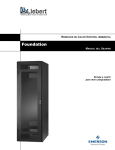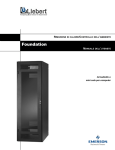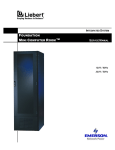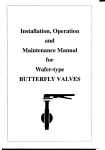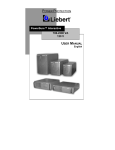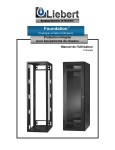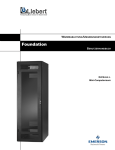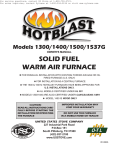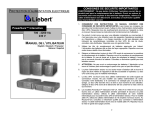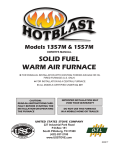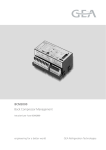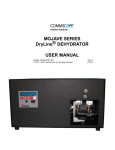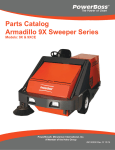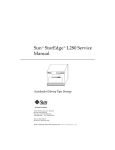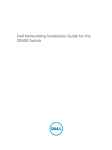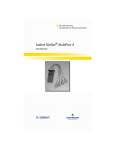Download Foundation - Emerson Network Power
Transcript
HEAT REMOVAL /ENVIRONMENTAL CONTROL Foundation USER MANUAL Enclosure & Mini Computer Room TABLE OF CONTENTS IMPORTANT SAFETY INSTRUCTIONS . . . . . . . . . . . . . . . . . . . . . . . . . . . . . . . . . . . . . . . . . . . . . . . .1 GLOSSARY OF SYMBOLS . . . . . . . . . . . . . . . . . . . . . . . . . . . . . . . . . . . . . . . . . . . . . . . . . . . . . . . .2 INTRODUCTION. . . . . . . . . . . . . . . . . . . . . . . . . . . . . . . . . . . . . . . . . . . . . . . . . . . . . . . . . . . . .3 GENERAL DESCRIPTION . . . . . . . . . . . . . . . . . . . . . . . . . . . . . . . . . . . . . . . . . . . . . . . . . . . . . . . .4 About this Manual . . . . . . . . . . . . . . . . . . . . . . . . . . . . . . . . . . . . . . . . . . . . . . . . . . . . . . . . .4 MAJOR COMPONENTS . . . . . . . . . . . . . . . . . . . . . . . . . . . . . . . . . . . . . . . . . . . . . . . . . . . . . . . . . .5 Frame. . . . . . . . . . . . . . . . . . . . . . . . . . . . . . . . . . . . . . . . . . . . . . . . . . . . . . . . . . . . . . . . . . .5 Enclosure . . . . . . . . . . . . . . . . . . . . . . . . . . . . . . . . . . . . . . . . . . . . . . . . . . . . . . . . . . . . . . . . . . . 5 Doors . . . . . . . . . . . . . . . . . . . . . . . . . . . . . . . . . . . . . . . . . . . . . . . . . . . . . . . . . . . . . . . . . . . . . . 5 Side Panels . . . . . . . . . . . . . . . . . . . . . . . . . . . . . . . . . . . . . . . . . . . . . . . . . . . . . . . . . . . . . . . . . 5 Power. . . . . . . . . . . . . . . . . . . . . . . . . . . . . . . . . . . . . . . . . . . . . . . . . . . . . . . . . . . . . . . . . . .6 Uninterruptible Power Supply . . . . . . . . . . . . . . . . . . . . . . . . . . . . . . . . . . . . . . . . . . . . . . . . . . . 6 Environmental . . . . . . . . . . . . . . . . . . . . . . . . . . . . . . . . . . . . . . . . . . . . . . . . . . . . . . . . . . . .6 Fan Cooling System and Options . . . . . . . . . . . . . . . . . . . . . . . . . . . . . . . . . . . . . . . . . . . . . . . . 6 Environmental Control Module. . . . . . . . . . . . . . . . . . . . . . . . . . . . . . . . . . . . . . . . . . . . . . . . . . . 6 ECM Heat Rejection . . . . . . . . . . . . . . . . . . . . . . . . . . . . . . . . . . . . . . . . . . . . . . . . . . . . . . . . . . . . . . . . . . 6 Back-up Cooling Module (BCM) . . . . . . . . . . . . . . . . . . . . . . . . . . . . . . . . . . . . . . . . . . . . . . . . . . . . . . . . . 7 Monitoring . . . . . . . . . . . . . . . . . . . . . . . . . . . . . . . . . . . . . . . . . . . . . . . . . . . . . . . . . . . . . . . . . . 7 INSTALLATION . . . . . . . . . . . . . . . . . . . . . . . . . . . . . . . . . . . . . . . . . . . . . . . . . . . . . . . . . . . . .9 PREPARATION . . . . . . . . . . . . . . . . . . . . . . . . . . . . . . . . . . . . . . . . . . . . . . . . . . . . . . . . . . . . . . .10 Inspection. . . . . . . . . . . . . . . . . . . . . . . . . . . . . . . . . . . . . . . . . . . . . . . . . . . . . . . . . . . . . . . . . . 10 Required Setup Equipment . . . . . . . . . . . . . . . . . . . . . . . . . . . . . . . . . . . . . . . . . . . . . . . . . . . . 10 Electrical Requirements . . . . . . . . . . . . . . . . . . . . . . . . . . . . . . . . . . . . . . . . . . . . . . . . . . . . . . . 10 Environmental Control Module (ECM) . . . . . . . . . . . . . . . . . . . . . . . . . . . . . . . . . . . . . . . . . . . . . . . . . . . Backup Cooling Module (BCM). . . . . . . . . . . . . . . . . . . . . . . . . . . . . . . . . . . . . . . . . . . . . . . . . . . . . . . . . FAN Cooling . . . . . . . . . . . . . . . . . . . . . . . . . . . . . . . . . . . . . . . . . . . . . . . . . . . . . . . . . . . . . . . . . . . . . . . Uninterruptible Power Supply (UPS). . . . . . . . . . . . . . . . . . . . . . . . . . . . . . . . . . . . . . . . . . . . . . . . . . . . . 10 10 10 10 Site Preparation . . . . . . . . . . . . . . . . . . . . . . . . . . . . . . . . . . . . . . . . . . . . . . . . . . . . . . . . . . . . . 11 Wall-Mount Enclosures . . . . . . . . . . . . . . . . . . . . . . . . . . . . . . . . . . . . . . . . . . . . . . . . . . . . . . . . . . . . . . . .11 UNLOADING . . . . . . . . . . . . . . . . . . . . . . . . . . . . . . . . . . . . . . . . . . . . . . . . . . . . . . . . . . . . . . . . 12 Unloading the Foundation . . . . . . . . . . . . . . . . . . . . . . . . . . . . . . . . . . . . . . . . . . . . . . . . . . . . . 12 Unloading a Foundation Enclosure (HK/RK). . . . . . . . . . . . . . . . . . . . . . . . . . . . . . . . . . . . . . . . . . . . . . . 12 Unloading a Foundation MCR (HD/RD) . . . . . . . . . . . . . . . . . . . . . . . . . . . . . . . . . . . . . . . . . . . . . . . . . . 12 i FRAME & ENCLOSURE CONFIGURATIONS . . . . . . . . . . . . . . . . . . . . . . . . . . . . . . . . . . . . . . . . . . . 13 Internal Mounting Rails . . . . . . . . . . . . . . . . . . . . . . . . . . . . . . . . . . . . . . . . . . . . . . . . . . . . . . . 13 Front and Rear Mount Rails—Position . . . . . . . . . . . . . . . . . . . . . . . . . . . . . . . . . . . . . . . . . . . . . . . . . . . 13 Center Mount Rails—Position . . . . . . . . . . . . . . . . . . . . . . . . . . . . . . . . . . . . . . . . . . . . . . . . . . . . . . . . . . 13 Equipment Positioning . . . . . . . . . . . . . . . . . . . . . . . . . . . . . . . . . . . . . . . . . . . . . . . . . . . . . . . . 13 Mounting Hardware . . . . . . . . . . . . . . . . . . . . . . . . . . . . . . . . . . . . . . . . . . . . . . . . . . . . . . . . . . 13 Door—Remove and Reverse. . . . . . . . . . . . . . . . . . . . . . . . . . . . . . . . . . . . . . . . . . . . . . . . . . . 14 Remove the Door . . . . . . . . . . . . . . . . . . . . . . . . . . . . . . . . . . . . . . . . . . . . . . . . . . . . . . . . . . . . . . . . . . . Quick Door Removal . . . . . . . . . . . . . . . . . . . . . . . . . . . . . . . . . . . . . . . . . . . . . . . . . . . . . . . . . . . . . . . . . Reverse the Door . . . . . . . . . . . . . . . . . . . . . . . . . . . . . . . . . . . . . . . . . . . . . . . . . . . . . . . . . . . . . . . . . . . Reverse the Door Handle . . . . . . . . . . . . . . . . . . . . . . . . . . . . . . . . . . . . . . . . . . . . . . . . . . . . . . . . . . . . . 14 14 14 14 Side Panels—Remove and Replace . . . . . . . . . . . . . . . . . . . . . . . . . . . . . . . . . . . . . . . . . . . . . 14 Remove a Panel . . . . . . . . . . . . . . . . . . . . . . . . . . . . . . . . . . . . . . . . . . . . . . . . . . . . . . . . . . . . . . . . . . . . 14 Replace a Panel . . . . . . . . . . . . . . . . . . . . . . . . . . . . . . . . . . . . . . . . . . . . . . . . . . . . . . . . . . . . . . . . . . . . 14 Cluster Configuration . . . . . . . . . . . . . . . . . . . . . . . . . . . . . . . . . . . . . . . . . . . . . . . . . . . . . . . . . 15 Cable Management . . . . . . . . . . . . . . . . . . . . . . . . . . . . . . . . . . . . . . . . . . . . . . . . . . . . . . . . . . 15 Cable Access—Sealed Units . . . . . . . . . . . . . . . . . . . . . . . . . . . . . . . . . . . . . . . . . . . . . . . . . . . . . . . . . . 16 Cable Access—Non-Sealed Units . . . . . . . . . . . . . . . . . . . . . . . . . . . . . . . . . . . . . . . . . . . . . . . . . . . . . . 16 STARTUP . . . . . . . . . . . . . . . . . . . . . . . . . . . . . . . . . . . . . . . . . . . . . . . . . . . . . . . . . . . . . . . . . . 17 OPERATION . . . . . . . . . . . . . . . . . . . . . . . . . . . . . . . . . . . . . . . . . . . . . . . . . . . . . . . . . . . . . . .18 ENVIRONMENTAL . . . . . . . . . . . . . . . . . . . . . . . . . . . . . . . . . . . . . . . . . . . . . . . . . . . . . . . . . . . . . 19 ECM (Environmental Control Module) . . . . . . . . . . . . . . . . . . . . . . . . . . . . . . . . . . . . . . . . . . . . . . . . . . . BCM (Backup Cooling Module). . . . . . . . . . . . . . . . . . . . . . . . . . . . . . . . . . . . . . . . . . . . . . . . . . . . . . . . . BCM Energy Saver . . . . . . . . . . . . . . . . . . . . . . . . . . . . . . . . . . . . . . . . . . . . . . . . . . . . . . . . . . . . . . . . . . Active Heat Rejection Options . . . . . . . . . . . . . . . . . . . . . . . . . . . . . . . . . . . . . . . . . . . . . . . . . . . . . . . . . Fan Cooling. . . . . . . . . . . . . . . . . . . . . . . . . . . . . . . . . . . . . . . . . . . . . . . . . . . . . . . . . . . . . . . . . . . . . . . . 19 19 19 20 20 UPS/SITENET INTEGRATOR . . . . . . . . . . . . . . . . . . . . . . . . . . . . . . . . . . . . . . . . . . . . . . . . . . . .21 Uninterruptible Power Supply . . . . . . . . . . . . . . . . . . . . . . . . . . . . . . . . . . . . . . . . . . . . . . . . . . 21 SiteNet Integrator® . . . . . . . . . . . . . . . . . . . . . . . . . . . . . . . . . . . . . . . . . . . . . . . . . . . . . . . . . . . . . . . . . . . . . . . . . . 21 SNI Sensor Options . . . . . . . . . . . . . . . . . . . . . . . . . . . . . . . . . . . . . . . . . . . . . . . . . . . . . . . . . . . . . . . . . 21 OPTIONAL EQUIPMENT . . . . . . . . . . . . . . . . . . . . . . . . . . . . . . . . . . . . . . . . . . . . . . . . . . . . . 23 OPTIONS . . . . . . . . . . . . . . . . . . . . . . . . . . . . . . . . . . . . . . . . . . . . . . . . . . . . . . . . . . . . . . . . . . . 24 Enclosure Systems . . . . . . . . . . . . . . . . . . . . . . . . . . . . . . . . . . . . . . . . . . . . . . . . . . . . . . . . . . 24 Internal Mounting Rails . . . . . . . . . . . . . . . . . . . . . . . . . . . . . . . . . . . . . . . . . . . . . . . . . . . . . . . . . . . . . . . 24 Door/Panel Options. . . . . . . . . . . . . . . . . . . . . . . . . . . . . . . . . . . . . . . . . . . . . . . . . . . . . . . . . . . . . . . . . . 24 General Enclosure Options . . . . . . . . . . . . . . . . . . . . . . . . . . . . . . . . . . . . . . . . . . . . . . . . . . . . . . . . . . . . 24 Power. . . . . . . . . . . . . . . . . . . . . . . . . . . . . . . . . . . . . . . . . . . . . . . . . . . . . . . . . . . . . . . . . . . . . 24 On-Line UPS Systems . . . . . . . . . . . . . . . . . . . . . . . . . . . . . . . . . . . . . . . . . . . . . . . . . . . . . . . . . . . . . . . 24 Line Interactive Systems . . . . . . . . . . . . . . . . . . . . . . . . . . . . . . . . . . . . . . . . . . . . . . . . . . . . . . . . . . . . . . 24 Power Strips . . . . . . . . . . . . . . . . . . . . . . . . . . . . . . . . . . . . . . . . . . . . . . . . . . . . . . . . . . . . . . . . . . . . . . . 24 Environmental . . . . . . . . . . . . . . . . . . . . . . . . . . . . . . . . . . . . . . . . . . . . . . . . . . . . . . . . . . . . . . 24 ECM Cooling Systems and Options . . . . . . . . . . . . . . . . . . . . . . . . . . . . . . . . . . . . . . . . . . . . . . . . . . . . . 24 BCM Cooling Systems and Options . . . . . . . . . . . . . . . . . . . . . . . . . . . . . . . . . . . . . . . . . . . . . . . . . . . . . 24 FAN Cooling Systems & Options . . . . . . . . . . . . . . . . . . . . . . . . . . . . . . . . . . . . . . . . . . . . . . . . . . . . . . . 24 Monitoring Options. . . . . . . . . . . . . . . . . . . . . . . . . . . . . . . . . . . . . . . . . . . . . . . . . . . . . . . . . . . 24 Mounting Options. . . . . . . . . . . . . . . . . . . . . . . . . . . . . . . . . . . . . . . . . . . . . . . . . . . . . . . . . . . . 24 ii MAINTENANCE . . . . . . . . . . . . . . . . . . . . . . . . . . . . . . . . . . . . . . . . . . . . . . . . . . . . . . . . . . . . 25 TROUBLESHOOTING . . . . . . . . . . . . . . . . . . . . . . . . . . . . . . . . . . . . . . . . . . . . . . . . . . . . . . . . . . . 26 PERIODIC MAINTENANCE . . . . . . . . . . . . . . . . . . . . . . . . . . . . . . . . . . . . . . . . . . . . . . . . . . . . . . . 27 Mini Computer Room . . . . . . . . . . . . . . . . . . . . . . . . . . . . . . . . . . . . . . . . . . . . . . . . . . . . . . . . . . . . . . . . 27 Rack Mount ECM . . . . . . . . . . . . . . . . . . . . . . . . . . . . . . . . . . . . . . . . . . . . . . . . . . . . . . . . . . . . . . . . . . . 27 Top Mount ECM . . . . . . . . . . . . . . . . . . . . . . . . . . . . . . . . . . . . . . . . . . . . . . . . . . . . . . . . . . . . . 27 Cleaning the Optional FAN Air Filter . . . . . . . . . . . . . . . . . . . . . . . . . . . . . . . . . . . . . . . . . . . . . 27 MCR START-UP INSPECTION CHECKLIST . . . . . . . . . . . . . . . . . . . . . . . . . . . . . . . . . . . . . . . . . . . 28 I. Site Conditions . . . . . . . . . . . . . . . . . . . . . . . . . . . . . . . . . . . . . . . . . . . . . . . . . . . . . . . . . . . . 28 II. Unit Start-Up and Operation. . . . . . . . . . . . . . . . . . . . . . . . . . . . . . . . . . . . . . . . . . . . . . . . . . 28 SPECIFICATIONS . . . . . . . . . . . . . . . . . . . . . . . . . . . . . . . . . . . . . . . . . . . . . . . . . . . . . . . . . . 29 MODEL NUMBERS, DIMENSIONS. . . . . . . . . . . . . . . . . . . . . . . . . . . . . . . . . . . . . . . . . . . . . . . . . . 30 Foundation Model Numbers. . . . . . . . . . . . . . . . . . . . . . . . . . . . . . . . . . . . . . . . . . . . . . . . .30 COOLING SYSTEMS . . . . . . . . . . . . . . . . . . . . . . . . . . . . . . . . . . . . . . . . . . . . . . . . . . . . . . . . . . . 36 POWER SYSTEMS . . . . . . . . . . . . . . . . . . . . . . . . . . . . . . . . . . . . . . . . . . . . . . . . . . . . . . . . . . . . 37 TABLES Table 1 Table 2 Table 3 Table 4 Table 5 Enclosure Dimensions . . . . . . . . . . . . . . . . . . . . . . . . . . . . . . . . . . . . . . . . . . . . . . . . . . . . . . . . . . . . Fan Performance Data . . . . . . . . . . . . . . . . . . . . . . . . . . . . . . . . . . . . . . . . . . . . . . . . . . . . . . . . . . . . ECM Performance Data . . . . . . . . . . . . . . . . . . . . . . . . . . . . . . . . . . . . . . . . . . . . . . . . . . . . . . . . . . . BCM Performance Data . . . . . . . . . . . . . . . . . . . . . . . . . . . . . . . . . . . . . . . . . . . . . . . . . . . . . . . . . . . UPS Performance Data . . . . . . . . . . . . . . . . . . . . . . . . . . . . . . . . . . . . . . . . . . . . . . . . . . . . . . . . . . . iii 30 36 36 36 37 Important Safety Instructions Save These Instructions Where applicable, this product must be permanently connected and powered from a suitable single-phase AC supply rated in accordance with the equipment data plate. It must be suitably grounded and protected by a circuit breaker or fuse. This manual contains important instructions that should be closely followed during installation and maintenance of this unit. Read all safety and operating instructions before attempting to operate the Foundation. Adhere to all warnings on the unit and in this manual. Follow all operating and user instructions. This equipment complies with the requirements of the EMC directive 89/336/EEC and the published technical standards. Continued compliance requires installation in accordance with these instructions and the use of manufacturer approved accessories with output cables not exceeding 30 feet (10 meters) in length. Use a shielded cable for external communications interface. This product is designed for Commercial / Industrial use only. This product is not intended for use with life support or other U.S. FDA designated “critical” devices. Maximum load must not exceed that shown on the Foundation rating label. Operate this product in an indoor environment at an ambient temperature of 65°F to 105°F (23°C to 40°C). Install in a clean environment, free from moisture, flammable liquids, gases, and corrosive substances. Ensure the Foundation has proper ventilation. Never block or insert objects into the ventilation holes or other openings. Maintain a minimum clearance of 12 inches (305 mm) in front, rear and top of the Foundation for proper air flow and cooling. Top-Mount ECMs require at least 24 inches on the Foundation’s sides. 1 Glossary of Symbols Warning! Hazardous Voltage Present Caution: Note following instructions Consult user manual for additional information Indicates weight Indicates ground connection Indicates alternating current 2 INTRODUCTION General Description About this Manual Major Components Frame Enclosure Power Environmental Monitoring 3 General Description About this Manual Congratulations on purchasing a Liebert Foundation. The highly versatile Foundation can provide an organized, secure, controlled environment in a single system for your sensitive electronic equipment. The Foundation’s flexibility means that a variety of configurations exist for the unit. The various sections cover: The original Little Glass House, on which the Foundation is based, won numerous awards for its innovative design and uniqueness. We’ve taken suggestions from you, our valued customers, to improve an already great product. A few of the improvements found in the Foundation are: • • • • • • • • • Frame—The basic setup; relevant to all Foundation configurations. • Enclosure—The types of doors and side panels, as well as attendant hardware, available as upgrades to accommodate various options. • Power—The wide selection of Uninterruptible Power Supply (UPS) models available for the Foundation. • Environmental—Computer-grade environmental conditioning units that may be employed: Environmental Control Module (ECM), Back-up Cooling Module (BCM) and FAN Fan Cooling. • Monitoring—Hardware to collect data about conditions within the Foundation and about its components. adjustable rack rails reversible door(s) easy access side panels multiple door options complete upgradability top-or bottom-mount ECM unit quieter ECM and fan operation energy saving features The Foundation is available in a variety of configurations to suit your electronic equipment’s environmental needs. Whether you need a rack to organize your electronic equipment, locking doors for security, a UPS for power protection, and/or an ECM air conditioner to keep your equipment at a constant temperature, the Foundation will provide the level of protection you require. Any or all of the components may be included in your Foundation, depending on the unit’s configuration. If, for example, your Foundation is equipped with an ECM, but no UPS or Monitoring equipment, you might want to read the sections on Frames, Enclosures and Environmental, skipping the sections titled Power and Monitoring. One of the best features of the Foundation is its flexibility. Initially, you might need only a basic enclosure unit. The Foundation can be upgraded to fit your changing needs as your operations expand and you add more sensitive electronic equipment. 4 Major Components Various cutouts in the top, bottom and rear plates permit customer cable entry; cover plates are provided as sealing and cooling options require. You may have any or all of the components discussed in this section, depending on your Foundation configuration. Frames are selected as either “non-sealed,” (open frame or enclosure), or as “sealed” (basis for NEMA12 enclosure). All options that are added to the Mounting Frame conform to either the sealed or non-sealed requirements as the sealing selection dictates. Frame The base of all Foundation products is the frame. It comes in four standard heights (24, 44, 78, and 84 inches). All 24-inch high units are wall-mountable and are furnished with doors, side panels, and 19" squarehole mounting rails. The 44-, 78-, and 84-inch frames can accommodate shelfor rack-mounted equipment on either 19- or 23-inch adjustable, square or threaded rails. See Model Numbers, Dimensions on page 30 and the subsequent illustrations for measurements of different models. All units (with the exception of the wall-mount units) have leveling feet and grounding lug. Casters are optional. Enclosure The Mounting Frame can be upgraded to an Enclosure system, or to a sealed Mini Computer Room, with the addition of factory-installed panel and door configurations, gaskets and other options. Doors All doors are framed from sheet metal. A multi-point latch with key lock is provided for security. All doors are removable and allow for reversible (left/right) hinging. The following doors are available: • • • • • Plexiglas™ front door Sheet metal front and rear door Insulation provided on ECM applications Perforated front and rear door Rear doors are available in either Full Height or with Cable Entrance panels, and as Single- or Dual-door designs. Side Panels Side panels are fashioned from sheet metal. Special fasteners inside and outside the unit permit removal of all panels for maintenance while preserving internal security during normal operation. The frame consists of heavy-duty, riveted 12-gauge steel construction, painted black. The front and rear vertical frame members accommodate Internal Mounting Rail options and provide space to route and manage customer cabling. Side panels are available in either solid or vented designs. An insulation option is required for Foundation systems that use ECM cooling. This provides improved thermal and sound insulation. 5 Power Environmental Control Module The Environmental Control Module (ECM) conditions and circulates the air inside the Foundation to protect your electronic equipment from heat the equipment generates. Outside (ambient) air is used to remove heat from the enclosure through the air-cooled condenser. The ECM is capacity/load-matched to Liebert’s UPS models, along with heat transmitted into the enclosure from outside. Uninterruptible Power Supply The Uninterruptible Power Supply (UPS) can provide your electronic equipment with: • Surge protection and suppression • Regulated voltage and frequency • Battery back-up A UPS protects your sensitive electronic equipment when utility power fails. It gives you time to perform a controlled shutdown of your operating system, preventing damage to the hardware, as well as allowing you to save valuable data. Liebert UPSs also condition utility power, eliminating power spikes that could damage your instruments. The ECM is available as either internal rack mount or external top mount. The ECM is not compatible with the 24" wall-mount Foundation enclosures. Liebert’s PowerSure Interactive and UPStation GXT 2U, up to 3000 VA, are available for the Foundation. Liebert UPStation GXT –+ AC INPUT BATTERY UPS ON BYPASS Environmental Control Module (Internal Rack-Mount) GXT2U UPS and additional Battery Cabinet ECM Heat Rejection Refer to the user manual for your UPS for further details. For applications in confined spaces (equipment rooms or closets), an optional, ceiling-mounted Heat Rejection Fan or direct-connect Heat Rejection Duct options are available to ventilate the space outside the Foundation. Environmental Fan Cooling System and Options Refer to separate installation instructions provided with these options. A Fan Cooling Module is available to circulate air through your Foundation, providing enhanced primary cooling for enclosure systems. Fan Cooling Module Heat Rejection Fan 6 Back-up Cooling Module (BCM) Monitoring For back-up cooling, an optional Backup Cooling Module can be added to the Foundation. When the selfcontained BCM senses an internal temperature 100°F (38°C), the Backup Cooling Module fans will circulate filtered ambient air through the enclosure. The BCM is not compatible with the 24" wall-mount or 44" tall Foundation enclosures. SiteNet Integrator—The SiteNet™ Integrator is a separate rack-mount unit that communicates the status of the Foundation via Ethernet SNMP communications. R 1 R MAIN SiteNet Integrator AUX UPS AUX MOD RELAY OUTPUTS K1 K2 C-NC-NO C-NC-NO 1 3 2 TEMP/HUM INPUTS DRY-CONTACT INPUTS 1 2 3 4 5 6 7 8 2 9 10 MODULE1 MODULE2 T H + T H + - POWER SUPPLY POWER JACK A BCM Energy Saver (ES) Control is an add-on device that reduces energy costs by allowing the BCM to operate as the primary enclosure cooler. The BCM ES Control along with the High Temperature Alarm monitors air conditions inside and outside the enclosure and, when appropriate, cycles off the ECM and activates the BCM, reducing energy consumption. + INPUT: 9VDC 1A RS-232 DB-9P CIRCULAR DIN - MAIN CONFIGURATION PORT TEMP SENSOR CHASSIS GROUND 28V, 1A ALL OUTPUTS: CLASS 2. ALL INPUTS: CLASS 2. RS-232 RJ-12 AUX NETWORK CONNECTION (TOKEN RING ONLY) STP DB-9S UTP RJ-45 SiteNet Integrator (front and rear) The SiteNet Integrator is available as an installed option for the Foundation MCR. Load Control Module (LCM)—The Load Control Module (LCM), an optional, add-on package to the Ethernet SiteNet Integrator, provides remote power management for up to six pieces of connected equipment. It also permits remote reboot, turning equipment on and off with direct control and shutdown based on pre-set alarm conditions. LCM installation includes mounting in the Foundation, connection to the Integrator, and power connection. See SiteNet Integrator & LCM Distributed Processing user manuals for detailed descriptions. SNI-GXT2U/PSI RS232 Interface Cable—Provides communications between the SiteNet Integrator and GXT2U or PSI UPS. It is required for SNI applications with a GXT2U or PSI UPS. Internal Temperature & Humidity—Factory-installed optional sensor to monitor temperature and humidity inside the Foundation. External Temperature & Humidity option—Fieldlocated sensor package with 30 foot cable that monitors temperature and humidity outside the Foundation. Door Ajar Sensor—Factory-installed optional micro switches to detect an open door. High Temperature Alarm—Factory-installed sensor / controller module to detect high temperature inside the enclosure, sound an alarm and activate the BCM, if present. Back-up Cooling Module on rear of Foundation Water Detector—Field-installed LT410S for singlepoint detection. This option requires Power Supply when an ECM is not supplied. Power Supply—Factory-installed 24 VAC power source required for High Temp Alarm and Water Detector options when an ECM is not supplied. Smoke Detector—Factory-mounted optional sensor that signals the presence of smoke to SiteNet Integrator. This option requires the High Temperature Alarm. 7 8 INSTALLATION Preparation Inspection Required Setup Equipment Site Preparation Unloading Unloading the Foundation Frame & Enclosure Configurations Front and Rear Mount Rails—Position Center Mount Rails—Position Cable Management Startup 9 Preparation Inspection Backup Cooling Module (BCM) Upon receiving your Foundation, examine the packaging for any signs of mishandling or damage. If any damage is noted, notify your local Liebert representative and your carrier. The BCM is an optional, self-contained backup cooling system. If the Foundation is supplied with a UPS and BCM, the BCM is powered from the UPS. All 120V/ 60Hz BCMs are equipped with 6-foot long cords with NEMA 5-15 input plugs. Required Setup Equipment All 230V/50Hz ECMs are equipped with IEC 320M plugs. The following tools are required to set up your Foundation: • • • • FAN Cooling Pallet jack Utility knife 1/2" (13mm) ratchet or wrench 10mm wrench (for adjusting rails) All 60Hz FAN units are supplied with NEMA 5-15 plugs. All cords are 15 feet long. All 230V/50Hz ECMs are equipped with IEC 320M plugs. Uninterruptible Power Supply (UPS) Electrical Requirements If your Foundation is equipped with an Uninterruptible Power Supply, it will require connection to a dedicated electrical circuit. Review the UPS’s user manual before connecting utility power to the unit. This section describes the electrical service requirements for your Foundation system and its options. For the full load amp requirements of each option, please refer to Cooling Systems on page 36 and Power Systems on page 37 or the component's user manual. Environmental Control Module (ECM) If your Foundation is equipped with an ECM, it should be powered from a dedicated electrical circuit. DO NOT plug the ECM into the optional UPS, or the same input circuit to the UPS. All 120V/60Hz ECMs are equipped with 9-foot long cords with NEMA 5-15 input plugs. All 230V/50Hz ECMs are equipped with IEC 320M plugs. 10 Site Preparation ! To keep the unit’s center of gravity as low as possible, install equipment from the bottom up, starting with the heavier units. For rack-mount ECM units, leave any additional available space (if any) at the top of the enclosure. For top-mount ECM units, any additional unused space should be as close to the bottom of the enclosure as possible while also attempting to maintain the lowest possible center of gravity. CAUTION When deciding where to place your Foundation Mini Computer Room, make sure the location has adequate ventilation to dissipate the heat rejected from the inside of the enclosure. Alcoves or closets should have louvered doors and/or open ceilings that promote air exchange. Liebert offers active heat rejection packages to assist in the removal of heat from these confined spaces. See Active Heat Rejection Options on page 20. Note the dimensions of your Foundation model to determine the required amount of space. Units with a Rack Mount ECM require at least 12 inches of clearance at the top, in front and at the rear. Do not block the airflow at the front or rear of the unit. Rack-Mount ECM Clearance Requirements 12" CAUTION After customer equipment is installed, the Foundation may have a high center of gravity, particularly when equipped with a top-mount ECM. Avoid tipping the unit when it is being moved. An optional stabilizing plate is available to enhance stability. All electrical receptacles and sockets in the vicinity of where the Foundation will be used must be ground/earth type Wall-Mount Enclosures In addition to the 12" front and rear clearance, Top Mount ECMs require an additional 12" of free space on the sides of the unit. All Units with an ECM require at least 36 inches of service clearance in front of the unit for access to the ECM. ! Foundation wall-mount enclosures are designed to be mounted onto permanent frame structures or building studs. When selecting the installation area for your Foundation wall-mount enclosure, ensure that the structure and the mounting hardware used for the Foundation enclosure are capable of supporting at least 285 lbs (129kg). Refer to the Foundation drawings in the SPECIFICATIONS section of this manual for mounting recommendations and precautions. 12" ! 12" 11 CAUTION Installer must ensure that the mounting surface and hardware can support the loaded cabinet weight of 285 lbs (129kg). Failure to do so may result in serious injury or death. Unloading Unloading the Foundation Unloading a Foundation MCR (HD/RD) 1. Using a pallet jack, move the Foundation MCR near the desired location. Cut the shipping bands with a utility knife and remove all cardboard and plastic. 2. Remove the two 2x4s from the sides of the unit. Remove the 2x6 from the rear of the unit. 3. Using a ratchet or wrench, remove the four lag bolts from the front of the skid. 4. Remove the 2x6 from the front of the unit. 5. Slide the 4x4 runner from under the front of the skid. 6. Move the unit forward until the skid and the unit tilt. 7. Roll the unit off front of the skid. Before you start unloading your Foundation, please note the unit weight of your model. This can found in the Specifications section of this manual. Use at least two people when moving the unit. Unloading a Foundation Enclosure (HK/RK) 1. Using a pallet jack, move the Foundation near the desired location. Cut the shipping bands with a utility knife and remove all cardboard and plastic. 2. Remove the four 2x2s nailed around the Foundation base. 3. Move the unit forward and roll it off the front of skid. Open the door and locate the keys, which will be inside the enclosure along with a T-handle wrench for removing the side panels. The front and rear locks use the same key. To open either door, rotate the key 1/4 turn clockwise to unlock the door, then lift the bottom of the handle. Pull the handle away from the unit and rotate it 90 degrees to open the door. Inspect the interior of the unit for any damage done in shipping. If any damage is noted, file a claim with the shipper and inform your Liebert supplier. 12 Frame & Enclosure Configurations Internal Mounting Rails Center Mount Rails—Position The Foundation can accommodate rack-mounted or free-standing computer and network equipment. Depending on the model, the unit features either 19-inch or 23-inch rack rails. These internal mounting rails will be either center mount rails or front and rear mount rails. Both types are adjustable for equipment of different sizes. Bolts holding the four center mount rails pass through slots running almost the entire length of the mounting assemblies. This makes the rails more easily adjustable. Mounting hardware compatible with front and rear mount rails includes a fixed shelf, fixed rails, a pullout shelf, 19-inch to 23-inch rack rail adapters, and keyboard trays. Each of these optional kits is supplied with installation hardware. • • Front and Rear Mount Rails—Position • • To reposition center mount rails: • • Front and rear mount rails are secured to the Foundation by carriage bolts that pass through horizontal slots in the frame. These slots permit you to change the front-to-rear distance between the rails as your application requires. Equipment Positioning • To position the rails: • • • • • • Determine the proper location of the rails. Loosen the bolts securing a rail to the frame. Move the rail to the desired position, using the angled row of diamond-shaped holes (at right) to get the rail square. The rail is properly aligned when the rail edge is aligned through center of the diamonds at the top and the bottom of the frame. (Each diamond represents a halfinch change.) Tighten the bolts securing the rails to the frame. Repeat for each of the three remaining rails. Install your rack-mounted equipment or the shelves to hold your free-standing equipment, making sure that your equipment and the UPS are switched off. Make sure that your equipment and the UPS are switched off. Determine the proper location of the rails. Loosen the nuts holding the rails to the mounting assemblies (four bolts hold each rail). Slide the rails to the proper position and retighten the bolts. Install your rack-mounted equipment. Leave available space (if any) at the top of the enclosure. • For units with a rack-mounted ECM, any unused rack space should be left at the top of the rack. This helps promote air distribution and prevents short-cycling of the ECM cooling circuit. For units with a top-mounted ECM, any unused rack space should be left as close as possible to the bottom of the rack while still maintaining a low center of gravity for the enclosure. This helps promote air distribution and prevents short-cycling of the ECM cooling circuit. Mounting Hardware Optional Mounting Clipnuts and Screws are available for mounting equipment to the mounting rails. Clipnuts are a clip with a welded nut that fits over vertical rack rail holes, allowing individual placement of the mounting hardware. Each clipnut and screw package includes 10 Clipnuts (type 10/32 or M6 threaded holes) and screws. Also available are screw packages (type 10/32) for the Threaded Hole - Internal Mounting Rail option. Detail of Rack Rail 13 Door—Remove and Reverse Reverse the Door Handle The doors available for the Foundation are removable for convenience when installing equipment. They also are reversible, enabling you to have the single-door open in a more convenient direction if it is near a wall or other equipment. After the door has been reversed, the door handle of your Foundation will operate without adjustment, but it will be upside down. Should you wish to reverse the handle, follow these steps: • Remove the Door • • • • Remove the bolts securing the lower half of each two-piece hinge to the door. Remove the lower half of each hinge. Lift the door straight up until the pins clear the hinges. Set the door in a safe place. • • Open the door and remove all the bolts holding the door handle and lock assembly, including the four brackets (two on the 44-inch unit). Studs and nuts secure the brackets to the door frame. Flip the door handle and lock assembly 180 degrees and reattach it with the bolts and nuts. Check the handle and lock to ensure they operate properly. Side Panels—Remove and Replace Foundation side panels are simple to remove and replace, making it easier to install equipment. Panel removal also improves access for maintaining or replacing equipment. Remove a Panel Remove this bolt first • Quick Door Removal For minimum-security installations that also require frequent and fast removal of the door, the lower half of the hinge assembly may be permanently removed. This allows for quick removal of an open door by lifting the door straight up until the pins clear the hinge mount. • • • Reverse the Door • • • • • • • • • After removing the door, take out the remaining bolts and screws to remove the top half of each hinge. Note the current positioning of the latches and hinges, and mark the corresponding new position on the opposite side of the frame. Use a Phillips screwdriver to remove the four latches (two on the 44-inch unit). Attach the latches on the opposite side. Attach the top half of the hinges on the side where the latches had been. Rotate the door 180 degrees from its original position. Hang the door by inserting its pins into the hinges. Reattach the bottom half of the hinges. Reseal any holes that remain from previous installation. • Inside the Foundation, locate the two security bolts in each side panel. (The security bolts are about halfway up the side of the panels; one is near the front edge of the panel and the other near the rear.) Remove the bolts with a 10mm wrench. Locate the four panel retainers on the outside of the Foundation panel. There is one retainer in each corner of the panel. Using the factory-supplied T-handle Allen wrench, turn the panel retainers 90 degrees counterclockwise. Lift the panel off the lip at the bottom of the Foundation and set it in a safe location. Replace a Panel • • • 14 Set the panel on the lip at the bottom of the Foundation frame. Using the factory-supplied T-handle Allen wrench, turn each of the four panel retainers 90 degrees clockwise. For additional security, insert and tighten the two security bolts inside the Foundation, using a 10mm wrench. Cluster Configuration rate your power and communications cables, reducing electromagnetic interference. Two or more Foundation units can be connected into a cluster, enabling you to keep several pieces of equipment together. The Universal Cable Management Channel supports cabling run horizontally from front-to-rear or from sideto-side. The channel is field-installed to the Internal Mounting Rails. Cables are slipped through them, then pulled to the equipment for attachment. To connect two units: 1. Remove the side panels from the sides of the units that will be bolted together (see Remove a Panel on page 14). 2. Find the holes for the four bolts that will connect the units. These holes are at the corners of the Foundation, near the panel retainers. 3. Place a star washer on each of the four bolts and insert the bolts into the bolt holes. 4. Put a jam nut on each bolt and tighten them. 5. Remove the Side Panel Bracket from the bottom of both frames. 6. Slide the Foundation units together with the bolts inserted into the connection holes. 7. Put a Keps nut on each bolt and tighten securely. Universal Cable Management Raceway Mounting Positions Velcro straps are field-attached to the slots provided on the Internal Mounting Rails and support vertical cable management. Frame 1 Frame 2 Cable Management Once your equipment has been installed, you are ready to connect cables for power and communication. Before making any connections, check the equipment to ensure that all power switches are in the OFF position. Optional Velcro Strap Positioning on Rails Numerous cable entrances and management provisions are built into the various Foundation configurations to ease cable installation. NOTE When installing cables, leave enough slack for the unit to be rolled forward or sideways for access to components. Do not block or restrict cooling system (FAN, ECM or BCM - if provided) discharge or return airflow. Also, do not defeat the ground/earth connections between the utility/mains outlet and the Foundation. Optional Universal Cable Management Channel, Cable Rings, and Velcro Straps are available for routing cables. These help not only to keep your cables organized but also to sepaCable rings mounted on rail 15 Cable Access—Sealed Units Cable Access—Non-Sealed Units Top Cover and Back of Unit Top Cover and Back of Unit The back of the sealed unit has a Sealed Entrance Cable Raceway (a slot with foam gaskets) for cable access. Units with rack-mount ECM provide one raceway at the top of the unit, otherwise raceways are provided top and bottom. To use it, loosen the top half of the two-piece cover, pull your cables through the opening and replace the cover, making sure the gasket seals around the cables. Non-sealed Foundation models have cable openings at the rear of the top cover and above the rear door (see illustration below), unless the Full Height Rear Door option has been selected. Use either of the two rectangular holes for mounting a fan or fans and the other for cabling the unit. Two round 4" holes on the top of the Foundation and four round 1" holes on either side of the rectangular slot in the rear of the Foundation allow cable entry. Optional Sealed Entrance Cable Bundles (coneshaped seals and clamps) permit use of the round openings on the top and/or the bottom of the sealed Foundation for cable entry. Rear Top Cover of Non-Sealed Foundation The bottom rear of the Foundation has a rectangular slot and four round holes—two on either side—that can be used for cable entry. To bring cable through these holes: • • • • Replace the plug with a Sealed Entrance Cable Bundle. Pull the cable through the Bundle. The Cable Bundle can be trimmed to accommodate various quantities of cables. Use the clamp to secure the Bundle around the cables. Base of Unit Your non-sealed Foundation can be cabled from underneath through round 2" access holes lining both sides of the base. On units without an ECM, Backup Cooling Module or FAN, rectangular cable-access holes in the front and back of the base also are available for cabling. Base of Unit Sealed Foundations can be cabled from underneath through round 2.25" access holes lining both sides of the base. To install cable through these holes in a sealed Foundation, obtain Sealed Entrance Cable BunSealed Entrance dles, similar to the Cable Bundle one used for cabling through the top, from your Liebert representative. 16 Startup • Before plugging in your electronic equipment, make sure that all power switches are in the OFF position. Be certain there are no obstructions, wire bundles, manuals, trash, etc., in front of or on either side of the ECM, if your unit is so equipped. Make sure all doors are shut and sealed properly. Plug in the Environmental Control Module (ECM) into a dedicated utility circuit. • • Refer to the UPS manual for preparation for startup, details of UPS operation and the meaning of LED indicators. After you have complied with the manual’s instructions, turn on the UPS. Check the UPS’ indicators. If the UPS’s status is normal, proceed with the next step. Turn on your computer and network equipment. NOTE The UPS’s batteries may require recharging before it can fully supply your equipment’s power needs for the rated time if utility power fails. To charge the UPS batteries before using the unit, you can apply power to the UPS module while you are installing your equipment or while making adjustments. ECM's evaporator fan will begin to circulate air inside the enclosure as soon as power is supplied and will operate continuously. The compressor in the ECM is controlled by a thermostat located in the rear left corner of the ECM. This thermostat is factory set and does not require adjustment. If the setting is changed, contact Liebert Technical Support for assistance. The compressor in the Environmental Control Module will shut down if the ECM return air temperature drops below approximately 75°F (18°C). The evaporator fan will continue to circulate internal cabinet air throughout the sealed enclosure. The compressor will resume operating when the Foundation ECM return air rises above approximately 75°F (18°C). ! 17 CAUTION To avoid excessive condensation, turn off the Environmental Control Module whenever the cabinet may be open for more than 10 minutes, such as when removing doors and/or side panels while installing equipment. OPERATION Environmental 18 Environmental ECM (Environmental Control Module) BCM (Backup Cooling Module) The ECM is applicable to any sealed Liebert Foundation enclosure (designated by model numbers HD or RD). The Environmental Control Module (ECM) is sized to match the load capacity of the UPS system and the ambient heat transmitted into the Foundation. The module is located at the bottom of the enclosure or field-installed on top of the Foundation. If your Foundation MCR is equipped with the Backup Cooling Module (BCM) option, the BCM will automatically start if the High Temperature Alarm Module detects an internal cabinet temperature of 100°F (38°C). The BCM will draw filtered exterior air into the Foundation MCR cabinet for use as supplemental cooling and exhaust cabinet heat through the rear door. An audible alarm will sound until the cabinet temperature decreases below 100°F (38°C) or is silenced by depressing the Alarm Silence switch on the High Temperature Alarm Module. Backup Cooling requires the High Temperature Alarm Module option. The High Temperature Alarm Module also includes a dry contact for optional remote monitoring of a high temperature condition. A separate Control Cable connects the BCM to the High Temperature Alarm Module. The BCM is normally powered through a 6-foot cord with NEMA 5-15 plug connected to the factory-installed UPS, but could also be powered from a source outside the cabinet. Outside (ambient) air is used to remove heat from the enclosure through the air-cooled condenser. The outside air is drawn through the louver at the front of the ECM unit and discharged at the rear of the ECM. The ECM isolates outside air from the unit's internal cooling circuit. The compressor in the Environmental Control Module will shut down if the ECM return air temperature goes below 75°F (18°C), but the internal cabinet air will be continuously circulated by the evaporator fan. The compressor will resume operating when the Foundation ECM return air is above 75°F (18°C). The ECM is equipped with a factory-set hot gas bypass valve so that the compressor will operate nearly continuously for maximum compressor life. This valve modulates automatically to match compressor capacity to the load. Consult Liebert Technical Support if factory adjustment is desired. BCM Energy Saver The Backup Cooling Energy Saver (ES) is a factoryinstalled option that is useful in applications involving low exterior cabinet ambient temperatures and humidity. An enthalpy controller is used to detect the exterior cabinet ambient conditions. If the exterior ambient conditions are suitable, the Energy Saver operation will disable the ECM and enable the Back-Up Cooling system to draw filtered exterior air into the Foundation MCR cabinet for use as cooling. The High Temperature Alarm Module monitors the interior cabinet temperature and if the interior temperature is less than 90°F (32°C) and the exterior conditions suitable, turns on the Backup Cooling ES and disables the ECM. If the cabinet temperature increases above 90°F (32°C), the Backup Cooling ES is disabled for a period of one hour and the ECM is enabled to supply cabinet cooling. The one-hour time-out prevents cycling of the ES option. The ECM requires no external plumbing connections because excess condensate is evaporated into the unit's heat rejection airstream. A condensate drain tube (3/8" OD copper) is provided with the ECM. This drain connection will route excess condensate out of the unit in the event of an extreme condition, such as if a door is left open for an extended period while the ECM is operating, or in extremely humid environments. ! CAUTION To avoid excessive condensation, turn off the ECM any time a Foundation door is open for longer than 10 minutes. Also ensure that any cable entry points are sealed from external conditions via the optional Sealed Entrance Cable Bundles or Raceways. 19 Active Heat Rejection Options Fan Cooling Your Foundation requires external airspace to allow for dissipation of the heat rejected from the inside of the enclosure. The Heat Rejection Fan (HRF) is offered as a field-installed option to assist in the removal of rejected ECM heat from tight spaces or alcoves without adequate ventilation. The package includes a combination blower with inlet air louver plate. The package provides provisions for ceiling grid installation and connection of customer-supplied 8" diameter exhaust duct (if required). The HRF is hard-wired in the field and requires a 120VAC, 60Hz, 15A power source or a 230VAC 50Hz, 10A power source. Fan cooling is used in lieu of the ECM / BCM cooling options. Fan cooling can be provided by a single fan or by dual fans; a total of five fans can be installed in the unit. Outside air is drawn through the openings at the bottom of the front and back of the unit and is discharged at the top of the unit. All 60Hz FAN units are supplied with NEMA 5-15 plugs on 15-foot cords. The optional FAN filter is located behind the intake air openings at the front and rear doors of the Foundation. It should be checked periodically and cleaned. Remove the nuts securing the filter clips. Take out the filter and wash it in soapy water. Then rinse, dry and replace it. Replace the filter clips and secure to the Foundation. The ECM Heat Rejection Duct connects directly to the enclosure and is available as an alternative to the Heat Rejection Fan. The package includes a flexible, round duct that is 12 ft. long (365.76cm) and 8 in. (20.32cm) in diameter. The duct is field-attached to the Foundation MCR and routed as required. An in-line booster fan, powered by customer connection, is also included to overcome duct static pressure. This option is available for 50Hz and 60Hz applications. 20 UPS/SiteNet Integrator Uninterruptible Power Supply When the High Temperature Alarm module is present, contacts are provided to annunciate a High Temperature Alarm condition inside the cabinet. Customer connection is via 0.25" quick-connect terminals on the High Temperature Alarm Module in the upper right rear of the cabinet. The contacts are rated for 2 amps, 30 volts (Class 2 wiring). The Foundation may be supplied with any of several Liebert UPS units, or with no UPS. For integrated/ matched models, the UPS and ECM are sized with matched capacities. A larger UPS, with more battery time, can be obtained, but the connected electronics load should not exceed the ECM equipment load rating. Exceeding the ECM rating could cause high temperatures that might damage the equipment housed in the Foundation. SNI Sensor Options All the options above are available factory-installed with the order or for field installation. Field-installed options are shipped as kits containing the sensors with mounting hardware, cable and cable restraint fixtures. Field installation requires hand tools for terminating the control cables and routing the cables. For Foundation models supplied with a UPS, refer to the separate UPS manual for UPS operation and specifications. SiteNet Integrator® Door Ajar—This option consists of two normally open switches that are mounted on the cabinet's front and rear frame supports. The switches will indicate the position of the doors as opened or closed. This is determined by the status of the dry-contact inputs connected to the SiteNet Integrator. The Liebert SiteNet Integrator is a separate rackmount unit that communicates the status of the UPS and the Foundation. The option consists of a SiteNet Integrator module that typically is mounted in the top of the Foundation cabinet. Temperature and Humidity Sensors (Internal and External)—The sensors allow monitoring of temperature and humidity status by the SiteNet Integrator. The internal option is for installation inside the Foundation cabinet and is supplied with a 38 inch cord for connection between the temperature/humidity sensor and the SiteNet Integrator. The external option is supplied with a 30-foot (9m) cord for monitoring of temperature/ humidity status outside the Foundation cabinet. The sensor and connection requirements for both options are identical. The SiteNet Integrator is powered by one or two externally mounted power supplies. One is standard; the second provides optional input power redundancy for the SNI. These power supplies provide the 9 VDC required to power the Integrator module. One supply will be plugged into the UPS or the UPS outlet strip in the rear of the cabinet. The power supply output cable is plugged into the SiteNet Integrator Power Supply Main input receptacle/ socket. The second supply (if present) must be on a different circuit. The second supply’s output cable is plugged into the SiteNet Integrator Power Supply Auxiliary input receptacle/socket. Water Detect—The water detect option includes a Liebert Liqui-tect (LT-410) dry contact sensor. The sensor is powered by a 24VAC source connected through the High Temperature Alarm module. The transformer for this source is inside the ECM or BCM (an optional 120V transformer is available when no ECM is present). An optional UPS/SNI interface cable is available that allows transmission of information between the Liebert UPS and the SiteNet Integrator. This cable will plug into the DB-9 connector on the rear of the UPS. The opposite end of the cable is plugged into the connector on the rear of the SiteNet Integrator marked UPS RS-232 DB-9P. Additionally, the SiteNet Integrator is capable of monitoring two Liebert temperature/humidity sensors, a single temperature-only sensor, up to 10 digital/dry contact inputs, and includes two user-programmable relays. The water detector is connected to a dry-contact input on the rear of the SiteNet Integrator by a 9-foot cable. The detector typically is located outside the Foundation cabinet for external water detection. 21 High Temperature Alarm Option - The High Temperature Alarm is a factory installed sensor / controller module to annunciate high temperatures in the Foundation. When temperatures in the Foundation reach 100°F (38°C), an audible alarm and the BCM (if present) are activated. The High Temperature Alarm Module also includes a dry contact for optional remote monitoring of a high temperature condition. The High Temperature Alarm is powered by the ECM, if the ECM is not included with the Foundation system, a Power Supply option is required. The High Temperature Alarm Module also provides input power to the smoke detector option. Smoke Detector Option—A four-wire smoke detector with normally open contacts, heat sensor and sounder alarm is mounted in the top of the Foundation cabinet. If smoke is detected, the normally open contacts of the smoke detector will close to provide alarm status to the Integrator. The smoke detector sounder alarm will also activate. This alarm is silenced by removing input power to the smoke detector. The smoke detector option requires a 9VDC power source and is normally powered by the High Temperature Alarm Module. 22 OPTIONAL EQUIPMENT Options Environmental Monitoring Options 23 Options Enclosure Systems Environmental Internal Mounting Rails Proper temperature levels are maintained by configuring your Foundation with the options below. • • Front /Rear Rails Center Mount Rails ECM Cooling Systems and Options Door/Panel Options • • • • • Plexiglas doors Perforated doors Sheet metal doors Side Panels • • • • General Enclosure Options • • • • • • • • • • • Casters External Keyboard Trays Sealed Entrance Cable Raceway Sealed Entrance Cable Bundle Internal Light Cable Rings Universal Cable Management Channel Velcro Cable Management Straps Enclosure Cluster Kit Stabilizing Plate Lifting Lugs BCM Cooling Systems and Options • • • • • The Foundation is available with any of the following UPS models: FAN1000: single axial fan, low noise or high ambient FAN2000: dual axial fans, low noise or high ambient FAN Filter Monitoring Options • • • • • • • • • • On-Line UPS Systems GXT2 - 1000, 1500, 2000 and 3000 Line Interactive Systems • PS700, 1000, 1400 and 2200 Both types of the rack-mount UPSs above are available in either 120V or 230V versions. Power Strips • • • • BCM1000: for 1000 VA or less UPS load, rear door mount, low noise BCM2000: for 2000 VA or less UPS load, rear door mount, low noise FAN Cooling Systems & Options Power • ECM1000L: for 1000 VA or less UPS load, rack- or top-mount (field-installed), low noise ECM2000L: for 2000 VA or less UPS load, rack- or top-mount (field-installed), low noise ECM Heat Rejection Fan ECM Heat Rejection Duct ECM Extension Duct (for multi-enclosure applications) 6 outlet / 15 Amp-120 VAC 10 outlet / 15 Amp-120 VAC 10 outlet / 20 Amp-120 VAC 10 outlet /10 Amp-230 VAC SiteNet Integrator Load Control Module SNI-GXT / PSRS232 Interface Cable Internal Temp / Humidity Option - SNI Interface External Temp / Humidity Option - SNI Interface Door Ajar Sensor Option High Temp Alarm Water Detected Option Power Supply (60Hz Only) Smoke Detected Option Mounting Options • • • • • • • • • 24 Fixed shelves, vented, 250lb (113kg) capacity Pullout shelves, vented, 130lb (59kg) capacity Fixed Rails, 150lb (68kg) capacity External Keyboard Tray Internal Keyboard Tray (19" Rack Keyboard) HD/K Mounting Frames 19" Internal Keyboard Tray (Std Keyboard) - RD/K Mounting Frames 23" Mounting Clipnuts and Screws 10-32 or M6 Thread (10 sets) Mounting Screws for Threaded Rail option (qty 24) 23" - 19" Rack Rail Adapters—1U, 2U, 3U, 4U, 5U and 10U MAINTENANCE Troubleshooting Periodic Maintenance MCR Start-Up Inspection Checklist 25 Troubleshooting Problem ECM not cooling Cause Solution No Power Confirm unit is plugged in and the building breaker has not tripped. Clogged condenser coil Clean coil. See Periodic Maintenance on page 27. Hot Gas bypass valve set incorrectly Contact Liebert Technical Support. Refrigerant loss Verify leak. If refrigerant system needs repaired, contact Liebert Technical Support. ECM airflow is blocked at the intake or exhaust. Remove airflow obstructions from the front & rear of the enclosure, ensure the cabinet has at least 12" front & rear clearance. Open Foundation doors and let compressor cool. Plug ECM in and verify compressor is energized. Compressor trips on thermal overload Open Foundation doors and let compressor cool. Plug ECM in and verify compressor is energized. Fans blowing warm air Faulty Compressor Contact Liebert Technical Support. Excessive opening of doors Condensate draining continuously from rear drain Reduce amount of opening. Get optional external keyboard tray. Unplug ECM when opening doors for extended period. Enclosure not properly sealed Check cable entry points, and verify doors and side panels are closed. Reposition wires to prevent air leak, or fix or replace damaged gaskets. Water Leaking from inside the cabinet Evaporator drain kinked or clogged Remove ECM and verify plastic tubing is attached to drain. Contact Liebert Technical Support. Excessive vibration or noise Defective motor in blower or shipping damage Contact Liebert Technical Support. ECM is overloaded Verify the UPS load does not exceed ECM capacity. If no UPS, verify load of equipment does not exceed the ECM rating. Heat not rejected from room Verify that Foundation is located in room with air circulation and heat rejected from ECM is sufficiently removed. ECM not cooling Confirm unit is plugged in and the building breaker has not tripped. Check setting of ECM thermostat. Cabinet not sealed Check cable entry points, and verify doors and side panels are closed. Reposition wires to prevent air leak, or fix or replace damaged gaskets. High temp alarm module has detected an abnormal condition Press alarm silence button on the high temp alarm module in the upper rear of the cabinet. Use the “ECM not cooling”, “Fans blowing warm air” and “Cabinet is excessively hot” causes and solutions to determine course of action. Cabinet is excessively hot Audible alarm and cabinet is excessively hot 26 Periodic Maintenance Mini Computer Room Top Mount ECM The Foundation MCR requires very little maintenance. The ECM's condenser coil fins must be inspected periodically to determine the necessary cleaning interval based on conditions at the installation site. Depending on site conditions the coil fins may require cleaning as often as twice a month or as seldom as twice per year. The condenser is located at the bottom front of the ECM. If the fins become dirty and clogged, they should be gently vacuumed with a soft bristle brush or cleaned with compressed air. For Top mount ECM units, remove power to the ECM by unplugging the power cord. Remove the sheet metal cover from the ECM by removing all screws on the front and sides of the unit. Screws on the rear of the ECM do not need to be removed. Clean the unit by gently vacuuming with a soft bristle brush or cleaning with compressed air. Reinstall the cover and all screws before restarting the ECM. Cleaning the Optional FAN Air Filter Rack Mount ECM The optional FAN air filters, behind the intake air openings on the front and rear doors of the Foundation, should be inspected periodically to determine the necessary cleaning interval, based on conditions at your installation. If an air filter becomes dirty and clogged, it will require cleaning. To access the condenser fins open the front door of the Foundation MCR and remove the two retaining screws from the top of the front access plate. The plate will swing open freely once the screws are removed. After cleaning, swing the access plate back into position and replace the two screws. To do so: • • • Rack Mount ECM - Condenser Access Plate (inside view) 27 Remove the nuts securing the filter clips. Take out the filter and wash it in soapy water. Rinse, dry and replace it. Replace the filter clips and secure to the Foundation. MCR Start-Up Inspection Checklist I. Site Conditions II. Unit Start-Up and Operation ___ 1. Confirm at least 1 ft. (0.3m) clearance in front & behind the unit. No side clearance required. ___ 1. Confirm no ECM airflow obstructions: ___ External (1 ft. / 0.3m minimum clearance): Enclosure front, rear and top. ___ Internal: ECM discharge and return. Obstructions include manuals, cables, equipment overhanging shelves, etc. ___ 2. Confirm at least 1 ft. (0.3m) clearance above the top of the unit. ___ 3. Confirm service clearances: 3 ft. (1m) enclosure front, or provisions to move enclosure to allow for service access. ___ 2. Examine the positioning of equipment inside the cabinet. ___ Prevent short cycling of ECM airflow - no large spaces between electronic devices in the top and bottom of the cabinet. ___ Equipment with the highest heat load should be located as close to the ECM as possible. ___ Heaviest equipment installed near the bottom of the cabinet. ___ 4. Confirm site ventilation provisions: ECM is self-contained air-cooled system. ___ Sufficient ambient space to dissipate heat rejected by the ECM. ___ Ambient temperature range is 65°F (18°C) to 105°F (40°C). ___ If equipped with Heat Rejection Fan or Duct option, confirm electrical connection. ___ 3. Power up ECM: Apply power via the external cord/plug connection. ___ Confirm immediate internal ECM airflow: Inside enclosure, ECM right side (evap. discharge). ___ Confirm compressor engages within two minutes (return air must be > 75°F to start compressor). ___ 5. Confirm ECM condensate drain tube is routed out the back of the unit, flex tube is clear and not kinked. ___ 6. Confirm separate dedicated circuits for ECM & UPS are provided (not same duplex). ___ ECMs require a 120V/60Hz/15A, singlephase 2-wire plus ground circuit. ___ Check UPS (if provided) nameplate for input electrical requirements. ___ 4. Record the ECM working input voltage 120VAC (+10%): ____________________ ___ 5. Power up UPS (if provided). Record the UPS working input voltage (separate circuit): ____________________ ___ 6. Check Cabinet Seals—No gaps, loose cables, air leaks: ___ Door gaskets intact / free of damage. Close front & rear doors and confirm no visible seal violations. ___ Side panels and the frame have uniform sealing. ___ Cable entrance points are sealed. 28 SPECIFICATIONS UPS Performance Data Foundation Model Numbers Cooling Systems Fan Performance Data Fan Performance Data BCM Performance Data Power Systems UPS Performance Data 29 Model Numbers, Dimensions Foundation Model Numbers H D 7 8 8 A A A 1 K Frame Primary Cooling Backup Cooling UPS Monitoring H = 19" Rack R = 23" Rack 0 = None 1 = FAN1000L 2 = FAN1000H 3 = FAN2000L 4 = FAN2000H A = ECM1000LR B = ECM1000LT C = ECM2000LR D = ECM2000LT 0 = None A = BCM1000L B = N/A C = BCM2000L 0 = Standard K = 120 VAC, 60 Hz, 1 = SNI-SE (Ethernet) 1PH 2 = SNI+LCM S = 230 VAC, 50 Hz, 3 = SNI-ST (Token Ring) 1PH 4 = LCM Only K = Non-Sealed D = Sealed 30" = 14U* 36" = 18U* 44" = 22U 50" = 26U* 56" = 30U* 64" = 34U* 72" = 38U* 78" = 42U 84" = 46U 0 = None A = GXT2-1000 B = GXT2-1500 C = GXT2-2000 D = GXT2-3000 E =PS700RM (H = High Ambient) F = PS1000RM G = PS1400RM (L = Low Noise) H = PS2200RM Voltage (H = High Ambient) (L = Low Noise) (R = Rack-Mount) (T = Top-Mount) 0= 30" Depth 8 = 38" Depth * Custom Sizes - Contact a Liebert representative for more details; some restrictions apply. Table 1 Enclosure Dimensions Overall Cabinet Dimensions Model H_440 H_448 R_440 R_448 H_780 H_788 R_780 R_788 H_840 H_848 R_840 R_848 Height* Width** Depth*** 42 (1067) 42 (1067) 42 (1067) 42 (1067) 77 (1956) 77 (1956) 77 (1956) 77 (1956) 84 (2134) 84 (2134) 84 (2134) 84 (2134) 23.5 (597) 23.5 (597) 27.5 (699) 27.5 (699) 23.5 (597) 23.5 (597) 27.5 (699) 27.5 (699) 23.5 (597) 23.5 (597) 27.5 (699) 27.5 (699) 29.5 (750) 37.5 (953) 29.5 (750) 37.5 (953) 29.5 (750) 37.5 (953) 29.5 (750) 37.5 (953) 29.5 (750) 37.5 (953) 29.5 (750) 37.5 (953) Rack Width EIA A Nominal in (mm) 19 (483) 17.8 (450) 19 (483) 17.8 (450) 23 (584) 22.8 (580) 23 (584) 22.8 (580) 19 (483) 17.8 (450) 19 (483) 17.8 (450) 23 (584) 22.8 (580) 23 (584) 22.8 (580) 19 (483) 17.8 (450) 19 (483) 17.8 (450) 23 (584) 22.8 (580) 23 (584) 22.8 (580) Adjustable Rack Depth Internal Rack Height Max**** Min. U in (mm) 22.5 (571) 30.5 (775) 22.5 (571) 30.5 (775) 22.5 (571) 30.5 (775) 22.5 (571) 30.5 (775) 22.5 (571) 30.5 (775) 22.5 (571) 30.5 (775) 18.5 (470) 26.5 (673) 18.5 (470) 26.5 (673) 18.5 (470) 26.5 (673) 18.5 (470) 26.5 (673) 18.5 (470) 26.5 (673) 18.5 (470) 26.5 (673) 22 22 22 22 42 42 42 42 46 46 46 46 38.5 (978) 38.5 (978) 38.5 (978) 38.5 (978) 73.5 (1867) 73.5 (1867) 73.5 (1867) 73.5 (1867) 80.5 (2045) 80.5 (2045) 80.5 (2045) 80.5 (2045) All dimensions are ± 0.1" (2.5mm) * Casters add 1.5" to overall height of frame. ** Side panels add 0.75" each to overall width of frame. Multiple frame/enclosure clustered systems add .188" (3/16") clearance width between frames. *** Front Doors add 0.25" each to overall depth and rear door adds no depth; BCM option adds an additional 3.00" to overall depth of frame. **** Dimensions are for Front/Rear Rail options. Rails can be inverted to provide an additional 4.00" of adjustment (2" per rail set). Center Mount Rail option adjustment depth: 30" Depth Frame =22" and 38" Depth Frame = 30". Restrictions apply with ECM Extension Duct applications. 30 31 32 33 34 35 Cooling Systems Table 2 Fan Performance Data Model Number Fans Airflow Sound CFM dBA Volts Hz Input Power (1 ph) FLA Plug NEMA 5-15P FAN1000L-60 1 114 47 120 60 0.2 FAN2000L-60 2 228 49 120 60 0.4 NEMA 5-15P FAN1000L-50 1 94 45 230 50 0.1 IEC320M-10A FAN2000L-50 2 188 47 230 50 0.2 IEC320M-10A FAN1000H-60 1 235 59 120 60 0.3 NEMA 5-15P FAN2000H-60 2 470 61 120 60 0.6 NEMA 5-15P FAN1000H-50 1 200 57 230 50 0.1 IEC320M-10A FAN2000H-50 2 400 59 230 50 0.2 IEC320M-10A Table 3 ECM Performance Data Rated Capacity Supported Load Max. Ambient Height** Width Depth Weight*** Total Heat Rej. BTUH (Watts) BTUH (Watts) °F (°C) In (mm) - U In (mm) In (mm) Lbs (kg) ECM1000L* -C60 5315 (1557) 2811 (824) 105 (41) 12.25 (311) - 7 17.43 (443) 29 (737) ECM1000L* -C50 5306 (1555) 2811 (824) 100 (38) 12.25 (311) - 7 17.43 (443) ECM2000L* -C60 6897 (2021) 5621 (1647) 105 (41) 12.25 (311) - 7 ECM2000L* -C50 6708 (1965) 5621 (1647) 100 (38) 12.25 (311) - 7 Model Number Input Power (1 ph) Sound BTUH (Watts) Volts Hz FLA dBA (1.5 m) 98 (44.5) 7146 (2094) 120 60 7.3 52 29 (737) 98 (44.5) 7698 (2255) 230 50 3.5 52 17.43 (443) 29 (737) 101 (45.8) 10935 (3204) 120 60 9.8 52 17.43 (443) 29 (737) 101 (45.8) 10375 (3040) 230 50 4.8 52 * T (top mount) and R (rack mount). ** Add 4.25" to Top Mount ECM units for interface plenum height. *** For Top-Mount ECM, add 39 lbs (18kg) to listed weights. Sound data based on sound pressure A- weighted scale for free field spherical radiation at 1.5 meters from cabinet. Sound data reflects only rack mount design. Consult factory for top mount data. Table 4 BCM Performance Data Rated Capacity Supported Load Max. Ambient Height Width Depth Total Heat Rej. BTUH (Watts) Btuh (Watts) °F (°C) In (Mm) In (Mm) In (Mm) Btuh (Watts) BCM 1000L-60 N/A 2811 (824) 105 (41) 35.0 (889) 15.5 (393.7) 3.75 (95.2) BCM 1000L-50 N/A 2811 (824) 105 (41) 35.0 (889) 15.5 (393.7) BCM 2000L-60 N/A 5621 (1647) 105 (41) 35.0 (889) BCM 2000L-50 N/A 5621 (1647) 105 (41) 35.0 (889) Model Number Input Power (1 ph) Sound Volts Hz FLA Plug dBA (1.5 m) 3038 (890) 120 60 1.0 NEMA 5-15 57 3.75 (95.2) 3038 (890) 230 50 0.5 IEC320M-10A 55 15.5 (393.7) 3.75 (95.2) 5918 (1734) 120 60 2.0 NEMA 5-15 59 15.5 (393.7) 3.75 (95.2) 5918 (1734) 230 50 1.0 IEC320M-10A 57 36 Power Systems Table 5 UPS Performance Data Input Power (1 ph) VA / Watts Height In (mm) U Volts WSA OPD Plug GXT2-1000RT120 1000 / 700 3.5 (89) 2 120 15 15 NEMA 5-15P GXT2-1500RT120 1500 / 1050 3.5 (89) 2 120 15 15 NEMA 5-15P GXT2-2000RT120 2000 / 1400 3.5 (89) 2 120 20 20 NEMA 5-20P GXT2-3000RT120 3000 / 2100 3.5 (89) 2 120 30 30 NEMA L5-30P Model Number GXT2-1000RT230 1000 / 700 3.5 (89) 2 230 10 10 IEC320M-10A GXT2-1500RT230 1500 / 1050 3.5 (89) 2 230 10 10 IEC320M-10A GXT2-2000RT230 2000 / 1400 3.5 (89) 2 230 10 10 IEC320M-10A GXT2-3000RT230 3000 / 2100 3.5 (89) 2 230 16 16 IEC320M-16A PS700RM-120 700 / 450 5.25 (133) 3 120 15 15 NEMA 5-15P PS1000RM-120 1000 / 670 5.25 (133) 3 120 15 15 NEMA 5-15P PS1400RM-120 1400 / 950 5.25 (133) 3 120 15 15 NEMA 5-15P PS2200RM-120 2200 / 1600 7 (178) 4 120 30 30 NEMA L5-30P PS700RM-230 700 / 450 5.25 (133) 3 230 10 10 IEC320M-10A PS1000RM-230 1000 / 670 5.25 (133) 3 230 10 10 IEC320M-10A PS1400RM-230 1400 / 950 5.25 (133) 3 230 10 10 IEC320M-10A PS2200RM-230 2200 / 1600 7 (178) 4 230 16 16 IEC320M-16A 37 HEAT REMOVAL /ENVIRONMENTAL PROTECTION Foundation USER MANUAL The Company Behind the Products With over a million installations around the globe, Liebert is the world leader in computer protection systems. Since its founding in 1965, Liebert has developed a complete range of support and protection systems for sensitive electronics: • • • • • Environmental systems—close-control air conditioning from 1 to 60 tons Power conditioning and UPS with power ranges from 300 VA to more than 1000 kVA Integrated systems that provide both environmental and power protection in a single, flexible package Monitoring and control—from systems of any size or location, on-site or remote Service and support through more than 100 service centers around the world and a 24/7 Customer Response Center While every precaution has been taken to ensure the accuracy and completeness of this literature, Liebert Corporation assumes no responsibility and disclaims all liability for damages resulting from use of this information or for any errors or omissions. © 2002 Liebert Corporation All rights reserved throughout the world. Specifications subject to change without notice. ® Liebert and the Liebert logo are registered trademarks of Liebert Corporation. All names referred to are trademarks or registered trademarks of their respective owners. SL-15610 (1/03) Rev. 1 Technical Support/Service Web Site www.liebert.com Monitoring 800-222-5877 [email protected] Outside the US: 614-841-6755 Single-Phase UPS 800-222-5877 [email protected] Outside the US: 614-841-6755 Three-Phase UPS 800-543-2378 [email protected] Environmental Systems 800-543-2778 Outside the United States 614-888-0246 Locations United States 1050 Dearborn Drive P.O. Box 29186 Columbus, OH 43229 Italy Via Leonardo Da Vinci 8 Zona Industriale Tognana 35028 Piove Di Sacco (PD) +39 049 9719 111 Fax: +39 049 5841 257 Asia 23F, Allied Kajima Bldg. 138 Gloucester Road Wanchai Hong Kong +852 2 572 2201 Fax: +852 2 831 0114










































